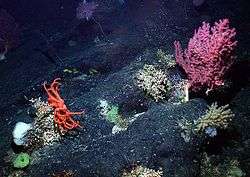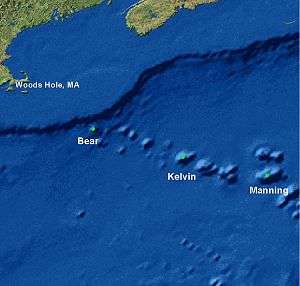New England Seamount chain
| New England Seamount chain | |
|---|---|
|
The New England Seamount chain | |
| Location | |
| Location | North Atlantic Ocean |
| Coordinates | 37°24′N 60°00′W / 37.400°N 60.000°WCoordinates: 37°24′N 60°00′W / 37.400°N 60.000°W |
The New England Seamount chain is an underwater chain of seamounts in the Atlantic Ocean stretching over 1,000 km from the edge of the Georges Bank off the coast of Massachusetts. The chain consists of over twenty extinct volcanic peaks, many rising over 4,000 m from the seabed.[1][2] It is the longest seamount chain in the North Atlantic and harbours a diverse range of deep sea fauna.[2] Scientists have visited the chain on various occasions to survey the geologic makeup and biota of the region. The chain forms part of the Great Meteor hotspot track, having formed by the movement of the North American Plate over the New England hotspot. The oldest volcanoes that were formed by the same hotspot are northwest of Hudson Bay, Canada.
Formation

The New England hotspot, also referred to as the Great Meteor hotspot, formed the White Mountains 124 to 100 million years ago when the North American continent was directly overhead. As the continent drifted to the west, the hotspot gradually moved offshore. On a southeasterly course, the hotspot formed Bear Seamount, the oldest in the chain, about 100 to 103 million years ago. Over the course of millions of years, it continued creating the rest of the seamounts, eventually culminating in the Nashville Seamount about 83 million years ago. As the Atlantic Ocean continued to spread, the hotspot eventually "travelled" further east, forming the Great Meteor Seamount south of the Azores, where it is found today.[3] The New England Seamounts were once at or above sea level. As time passed, however, and the chain moved farther away from the New England hotspot, the crust cooled and contracted, sinking back down to the ocean. The peaks are now all a km or more below the surface.

Biota
The seamount chain provides a unique habitat for deep sea marine creatures. Coral formations grow on the rocky outcrops, resembling underwater forests that provide shelter for invertebrates and fish.[4] Due to the expenses and difficulties of studying the deep ocean, little was known of the creatures that inhabited the New England Seamounts. In fact, before recent expeditions, there was only one known coral species in the entire chain.[2] Marine biologists caught and classified over 203 species of fish and 214 species of invertebrates on the Bear Seamount in various exploratory studies since 2000.[2] This range of diversity suggests that other seamounts may harbour more unknown macro-organisms. In fact, during one survey, a species of cutthroat eel believed to be found only near Australia was identified.[5] Corals, echinoderms, and crustaceans make up a large portion of the creatures found on the seamount. These organisms act as indicator species, identifying potential problems in the ecosystem.[2]
Seamounts

Seamounts within the New England Seamount chain include:
- Allegheny Seamount
- Asterias Seamount
- Balanus Seamount
- Bear Seamount
- Buell Seamount
- Gerda Seamount
- Gilliss Seamount
- Gosnold Seamount
- Gregg Seamount
- Hodgson Seamount
- Kelvin Seamount
- Kiwi Seamount
- Manning Seamount
- Michael Seamount
- Mytilus Seamount
- Nashville Seamount
- Panulirus Seamount
- Picket Seamount
- Physalia Seamount
- Rehoboth Seamount
- Retriever Seamount
- San Pablo Seamount
- Sheldrake Seamount
- Vogel Seamount
See also
References
| Wikimedia Commons has media related to New England Seamount Chain. |
- ↑ "Yale Peabody Museum: Invertebrate Zoology: Deep Sea Fauna from New England Seamounts". Yale Environmental News. Yale University. 2004. Retrieved 2007-07-31.
- 1 2 3 4 5 Ivar Babb (2005). "The New England Seamounts". National Oceanic and Atmospheric Administration. U.S. Department of Commerce. Retrieved 2007-07-31.
- ↑ "Geological Origin of the New England Seamount Chain". National Oceanic and Atmospheric Administration. U.S. Department of Commerce. 2005. Retrieved 2007-07-31.
- ↑ Susan Mills (2005). "Seamount Coral Communities". National Oceanic and Atmospheric Administration. U.S. Department of Commerce. Retrieved 2007-07-31.
- ↑ Petit, Charles (2004-08-08). "Denizens of the deep: In obscure marine ecosystems, clues to the origins of life". U.S. News & World Report. Retrieved 2007-07-31.
External links
- Overview of Studies of NW Atlantic Seamounts for the ISA. International Seabed Authority.
